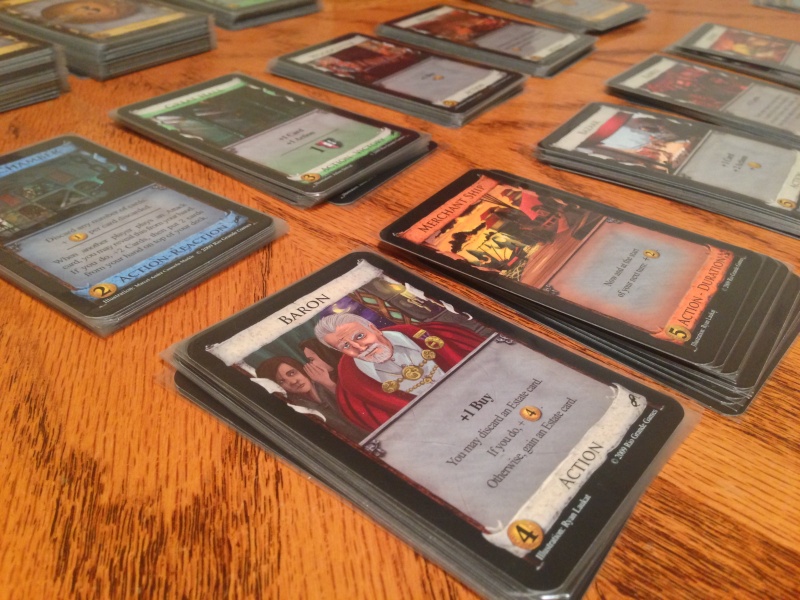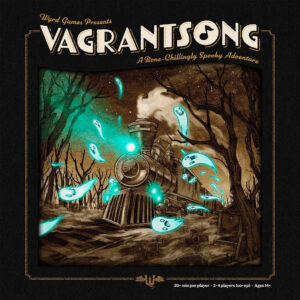 The following is an actual text exchange between Tony and me:
The following is an actual text exchange between Tony and me:
Me: …why did you send me that list?
Tony: What list?
Me: #3 – Smells like Teen Spirit, Nirvana #2 – Killing in the Name, Rage Against the Machine and #1- Crawling, Linkin Park
Tony: You asked for that list. Duh.
Me: No. I did not.
Tony: You did. You asked for my Top 3 vague rant songs.
Me: NO! I asked you if Vagarantsong is in your Top 3. As in Top 3 GAMES.
I didn’t wait for is reply. I got a copy of Vagrantsong and decided to review it for myself.
Gameplay Overview:
Vagrantsong is a cooperative boss battler for one to four players, with each of the 20+ scenarios lasting between 45 and 90 minutes. No, this is not the tabletop version of the excellent Square RPG video game. That was Vagrant STORY.
In Vagrantsong, players will control one of six different Vagrants that are onboard a ghost train. They will have to solve the mystery of the train while simultaneously battling Haints (ghost bosses) to return humanity to the Haints and release them from the train.
No, I was not intoxicated when I wrote that. That is the central idea of Vagrantsong.
Each scenario is made up of an undetermined number of rounds. Each round consists of each Vagrant taking a turn (players can determine which who will go as there is no predetermined order), followed by the Haint taking a turn. For example, in a three-player game, a round consists of six turns, with each Vagrant going once, for a total of three turns, while the Haint will activate three times.
Players spend their three coins to activate Actions, with the option of placing more than one coin on the same action to either activate that action multiple times or increase the chance of success. These coins return to the player at the start of their next turn.
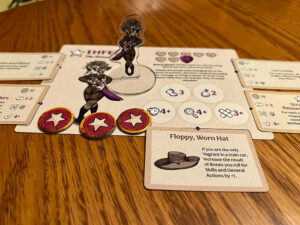
The available actions are as follows:
• Move – move orthogonal spaces equal to the Vagrant’s speed times the number of coins
• Rummage – draw a number Rummage Tokens from the Bindle (cloth sack) equal to the number of coins
• Investigate – if in a space with an Event Token, roll the number of dice equal to the number of coins – each result that equals or exceeds that Vagrant’s Investigate Value is a success
• Patch Up – roll the number of dice equal to the number of coins – each result that equals or exceeds that Vagrant’s Patch Up Value restores one lost Humanity (health)
• Bust – roll the number of dice equal to the number of coins – each result that equals or exceeds that Vagrant’s Bust Value inflicts one Humanity on the Haint
• Use a Skill – each character can have up to four skills equipped – the impact of the number of coins depends on the skill
The Haint turn is much simpler (supposedly, more on that later):
• Draw a Rummage Token from the bag to determine its Action
• Determine its target based on Targeting Priority
• Move the Haint, if applicable
• Resolve the Action
• Add the Rummage Token to the Cycle Track
Regardless of if the players lose by everyone being Westbound (run out of health) or fail a scenario specific requirement, or win, players move onto the next scenario. This will repeat until the final scenario.
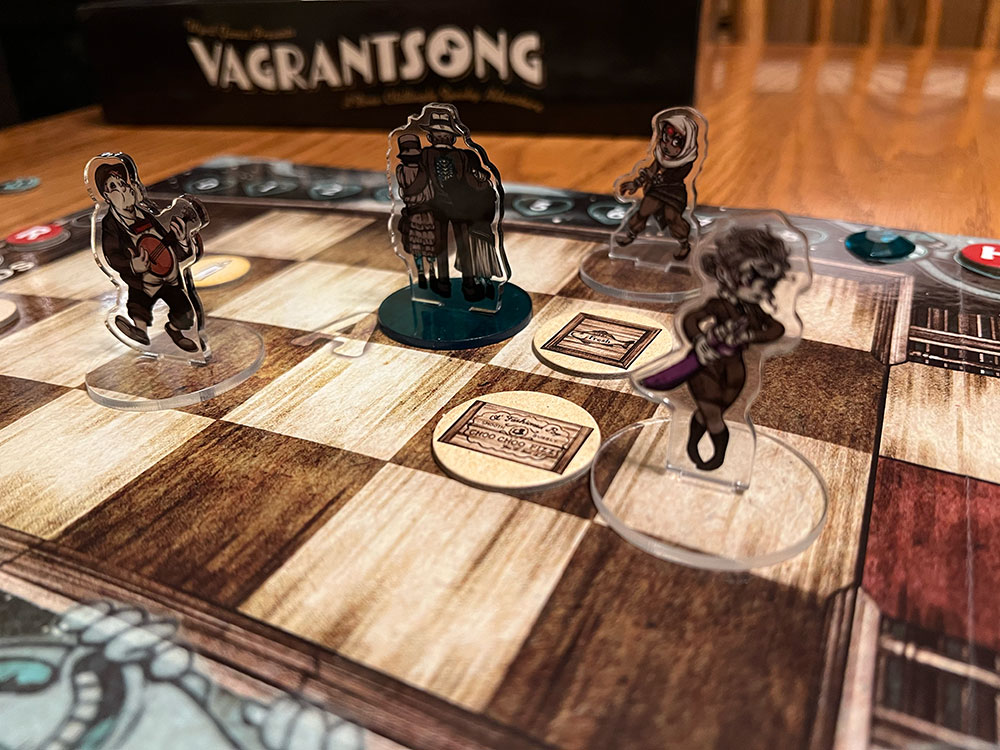
Game Experience:
I played through the campaign once, but my review will be spoiler free, so fret not. Due to the simplicity of adding/removing players, I was able to complete the campaign playing at all player counts.
What restored my Humanity
I LOVED the coin system used to pick your actions. Since you only have three coins (four if you spend a Rabbit’s Foot token), maximizing your turn was the most enjoyable part of the game for me. It sounds simpler than it is. Take movement, for example. Four of the six characters have a default movement of three, with the others having two. Movement in the game is orthogonal only. If terrain is between you and a Haint, a Vagrant with a move of two cannot get adjacent to the Haint without dedicating two coins.
Should they spend the two coins? Should one of the faster characters come over to assist instead, or do they need to save their coins for their turn? That is a simpler example as the number of spaces a coin generates is known. What about trying to maximize an attack? Should you spend all three coins on your attack, or do you need to Patch Up or Rummage for additional tokens? One thing I have not mentioned is that rolling a natural six allows you to roll another die, so a string of sixes when committing only one coin could end up being more powerful than if you committed all three and failed to roll one six. Finally, using skills adds another strategic consideration—they cannot be used in back-to-back turns unless explicitly allowed. Balancing all of these decisions and how to best spend your coins was my favorite mechanism of the game.

The Haints are fun to fight as well. They are all unique, and the first time you face them you spend the first half of the fight trying to understand their mechanics and how to overcome them. Every Haint has two moods that impacts their actions. There are five different actions per mood, with the action taken determined by drawing a token from the bindle and matching it to the appropriate action. Most actions have the Haint move towards a target and then attack. An additional threat is that they can, and will, pass through Vagrants, haunting them. The Haunted Effect is different in every scenario and can even vary based on the Haint’s mood. There are three rituals that can be completed for each scenario. These provide hints on how to combat the Haint, and provide rewards such as increasing the Haint’s humanity, rewarding coins to spend during the Camp Phase, etc…. The combination of random actions, flipping moods and scenario-specific variations provides a lot of replay value for Haint battling!
Third, I appreciated the Cycle Track mechanism. There is a track on the board where each of the five types of tokens drawn from the bindle are stored after they are discarded, be it after the Haint Action is complete or a Vagrant uses the token for its ability. When the limit for one of the tokens is reached, ALL of the tokens are placed back in the bindle and a Cycle Effect is triggered. These effects are… not good and, of course, are unique to each scenario. So why did I like this mechanism so much? It can impact your decision as to when to play a token. Let’s say you really want to play an Apple, which will Heal a wound. If the Apple discard pile only needs one more to trigger a Cycle Effect, you may want to delay spending it until the Cycle Effect is triggered by a different token later in the game. I really appreciate this additional mechanism to consider during your turn.
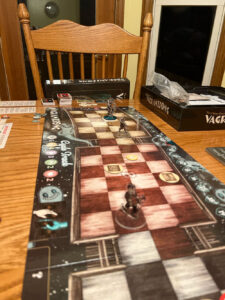
What forced me Westbound
The rules can be… confusing. I spent A LOT of time on BGG. Too much, in my opinion. The variability that comes with 20+ encounters can be a double-edged sword-what applies in one scenario may not be true in the next. Just as you become comfortable with a Haint, you move on to the next and have to learn all of the scenario-specific rules for that one.
Even more annoying is that the layout for each Haint is three pages. Setup is on the left, Actions are on the right, and Events are on the back of the Actions page. You will have to flip back and forth every time an event occurs. I started taking a picture of the Events page so I did not have to flip it anymore.
Finally, the character advancement is not as robust as I had hoped it would be. After every Scenario, there is a Camp phase, where you clean up from the completed scenario, spend coins for new skills and junk cards, and witness the In-Between (a bridge to the next scenario). The issue is that the junk and skills do not vary that much. There is not a big jump in power. There is a gameplay reason for this which I will not spoil, but I felt like I was making marked improvements to my character.
Final Thoughts:
Vagrantsong is a good cooperative boss battler. I enjoyed playing it, but I am not 100% sure I would recommend everyone to run out and buy it. It has some amazing gameplay mechanisms, but it gets bogged down by rules issues and layout problems. This is a great game for those that want to try out an inexpensive boss battler or like to own one-of-a-kind games.
Final Score: 3.5 Stars – A good boss battler that should at least be tried once due to its unique gameplay and theme.
 Hits:
Hits:
• Coin Based Action system
• Haints are fun to fight
• Cycle track
• Gameplay variability
• Theme and gorgeous art
Misses:
• Confusing rules
• Rulebook/Scenario Books are not well made
• Camp Phase/Character advancement







